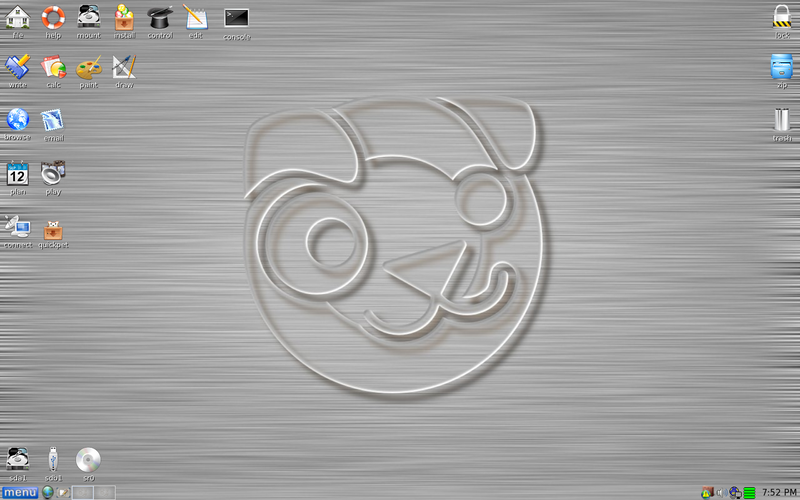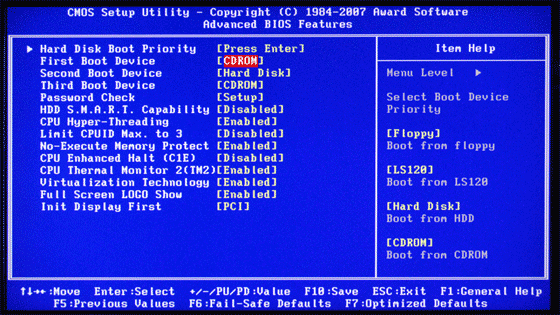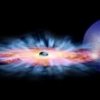I really appreciate the help!
Windows 7 will not boot. Not even in safe mode. [Closed]
Started by
MasterNega
, Nov 12 2013 07:20 PM
#16
![Windows 7 will not boot. Not even in safe mode. [Closed]: post #16](https://www.geekstogo.com/forum/public/style_images/shift/icon_share.png)
 Posted 14 November 2013 - 09:40 PM
Posted 14 November 2013 - 09:40 PM

I really appreciate the help!
#17
![Windows 7 will not boot. Not even in safe mode. [Closed]: post #17](https://www.geekstogo.com/forum/public/style_images/shift/icon_share.png)
 Posted 15 November 2013 - 02:37 AM
Posted 15 November 2013 - 02:37 AM

#18
![Windows 7 will not boot. Not even in safe mode. [Closed]: post #18](https://www.geekstogo.com/forum/public/style_images/shift/icon_share.png)
 Posted 15 November 2013 - 05:52 PM
Posted 15 November 2013 - 05:52 PM

I am unable to access the program.
I dont think the program supports my computer model. (Lenovo ideacentre k320)
I dont think the program supports my computer model. (Lenovo ideacentre k320)
#19
![Windows 7 will not boot. Not even in safe mode. [Closed]: post #19](https://www.geekstogo.com/forum/public/style_images/shift/icon_share.png)
 Posted 15 November 2013 - 09:09 PM
Posted 15 November 2013 - 09:09 PM

Okay, I am not convinced that is your problem anyway.
If necessary we can revisit that down the line.
For now please run FRST again but this time, before you run the scan uncheck the boxes:
Services
Drivers
Processes
Post the log back here.
If necessary we can revisit that down the line.
For now please run FRST again but this time, before you run the scan uncheck the boxes:
Services
Drivers
Processes
Post the log back here.
#20
![Windows 7 will not boot. Not even in safe mode. [Closed]: post #20](https://www.geekstogo.com/forum/public/style_images/shift/icon_share.png)
 Posted 16 November 2013 - 08:12 PM
Posted 16 November 2013 - 08:12 PM

Here is the log
Attached Files
#21
![Windows 7 will not boot. Not even in safe mode. [Closed]: post #21](https://www.geekstogo.com/forum/public/style_images/shift/icon_share.png)
 Posted 16 November 2013 - 08:42 PM
Posted 16 November 2013 - 08:42 PM

Please download the attached fixlist.txt file to your flashdrive .
NOTE. It's important that both files, FRST and fixlist.txt are in the same location or the fix will not work.
NOTICE: This script was written specifically for this user, for use on that particular machine. Running this on another machine may cause damage to your operating system
Now please enter System Recovery Options.
Run FRST64 and press the Fix button just once and wait.
The tool will make a log on the flashdrive (Fixlog.txt) please post it to your reply.
NOTE. It's important that both files, FRST and fixlist.txt are in the same location or the fix will not work.
NOTICE: This script was written specifically for this user, for use on that particular machine. Running this on another machine may cause damage to your operating system
Now please enter System Recovery Options.
Run FRST64 and press the Fix button just once and wait.
The tool will make a log on the flashdrive (Fixlog.txt) please post it to your reply.
#22
![Windows 7 will not boot. Not even in safe mode. [Closed]: post #22](https://www.geekstogo.com/forum/public/style_images/shift/icon_share.png)
 Posted 16 November 2013 - 10:56 PM
Posted 16 November 2013 - 10:56 PM

Still could not boot, still stuck on classpnp.sys
Here is the fixlog
Here is the fixlog
Attached Files
#23
![Windows 7 will not boot. Not even in safe mode. [Closed]: post #23](https://www.geekstogo.com/forum/public/style_images/shift/icon_share.png)
 Posted 17 November 2013 - 12:50 AM
Posted 17 November 2013 - 12:50 AM

Still could not boot, still stuck on classpnp.sys
Let's have another look then.
Please run another scan with FRST and post the FRST.txt back here.
#24
![Windows 7 will not boot. Not even in safe mode. [Closed]: post #24](https://www.geekstogo.com/forum/public/style_images/shift/icon_share.png)
 Posted 17 November 2013 - 03:06 PM
Posted 17 November 2013 - 03:06 PM

Here is the log
Attached Files
#25
![Windows 7 will not boot. Not even in safe mode. [Closed]: post #25](https://www.geekstogo.com/forum/public/style_images/shift/icon_share.png)
 Posted 17 November 2013 - 03:36 PM
Posted 17 November 2013 - 03:36 PM

Hmm... let's do this:
On the System Recovery Options menu you will get the following options:
Startup Repair
System Restore
Windows Complete PC Restore
Windows Memory Diagnostic Tool
Command Prompt
On the System Recovery Options menu you will get the following options:
Startup Repair
System Restore
Windows Complete PC Restore
Windows Memory Diagnostic Tool
Command Prompt
- Select Command Prompt
- In the command window type in notepad and press Enter.
- The notepad opens. Under File menu select Open.
- Select "Computer" and find your hard drive letter and close the notepad.
- In the command window type C: and press Enter
- Note: Replace letter C with the drive letter of your hard drive.
- Type in chkdsk /b and press Enter (notice the gap... it should be there.)
- When prompted, type in Y and press Enter.
- Allow chkdsk to perform all 5 stages. This may take some time, so please be patient.
- When complete, close the Command Prompt window, and click on the Restart button to restart your computer.
#26
![Windows 7 will not boot. Not even in safe mode. [Closed]: post #26](https://www.geekstogo.com/forum/public/style_images/shift/icon_share.png)
 Posted 17 November 2013 - 08:50 PM
Posted 17 November 2013 - 08:50 PM

Still unable to boot and i got , "Failed to transfer logged messages to the event log with status 50"


Edited by MasterNega, 17 November 2013 - 08:52 PM.
#27
![Windows 7 will not boot. Not even in safe mode. [Closed]: post #27](https://www.geekstogo.com/forum/public/style_images/shift/icon_share.png)
 Posted 17 November 2013 - 09:08 PM
Posted 17 November 2013 - 09:08 PM

Well not so good.
It does look like there are problems with your hard drive.
First things first, I think we should try and gain access so that you can back up any data you want to.
Now
Thank you to phillpower2 from our technical forums for putting this solution together.
This might be a way for you to access the hard drive to back up your data.
===================
***Required Hardware***
CD Burner (CDRW) Drive,
Blank CD,
Extra Storage Device (USB Flash Drive, External Hard Drive)
===================
1. Save these files to your Desktop/Burn Your Live CD:
2. Set your boot priority in the BIOS to CD-ROM first, Hard Drive Second
3. Recover Your Data
Remember to only click once! No double clicking! Once you drag and drop your first folder, you will notice a small menu will appear giving you the option to move or copy. Choose COPY each time you drag and drop.
YOU ARE DONE!!! Simply click Menu >> Mouse Over Shutdown >> Reboot/Turn Off Computer. Be sure to plug your USB Drive into another working windows machine to verify all data is there and transferred without corruption. Congratulations!

Tell me how you get on.
It does look like there are problems with your hard drive.
First things first, I think we should try and gain access so that you can back up any data you want to.
Now
Thank you to phillpower2 from our technical forums for putting this solution together.
This might be a way for you to access the hard drive to back up your data.
===================
***Required Hardware***
CD Burner (CDRW) Drive,
Blank CD,
Extra Storage Device (USB Flash Drive, External Hard Drive)
===================
1. Save these files to your Desktop/Burn Your Live CD:
- Download Latest Puppy Linux ISO (i.e.: lupu-528.iso)
Download BurnCDCC ISO Burning Software
There are instructions on how to boot from flash drive with puppy here; http://www.pendrivel...e-from-windows/
- Open BurnCDCC with Windows Explorer
- Extract All files to a location you can remember
- Double Click
 BurnCDCC
BurnCDCC - Click Browse
and navigate to the Puppy Linux ISO file you just downloaded
- Open/Double Click that file
IMPORTANT: Adjust the speed bar to CD: 4x DVD: 1x - Click Start

- Your CD Burner Tray will open automatically
- Insert a blank CD and close the tray
- Click OK
2. Set your boot priority in the BIOS to CD-ROM first, Hard Drive Second
- Start the computer/press the power button
- Immediately start tapping the appropriate key to enter the BIOS, aka "Setup"
(Usually shown during the "Dell" screen, or "Gateway" Screen) - Once in the BIOS, under Advanced BIOS Options change boot priority to:
CD-ROM 1st, Hard Drive 2nd - Open your ROM drive and insert the disk
- Press F10 to save and exit
- Agree with "Y" to continue
- Your computer will restart and boot from the Puppy Linux Live CD

3. Recover Your Data
- Once Puppy Linux has loaded, it is actually running in your computer's Memory (RAM). You will see a fully functioning Graphical User Interface similar to what you normally call "your computer". Internet access may or may not be available depending on your machine, so it is recommended you print these instructions before beginning. Also, double clicking is not needed in Puppy. To expand, or open folders/icons, just click once. Puppy is very light on resources, so you will quickly notice it is much speedier than you are used to. This is normal. Ready? Let's get started.
3a. Mount Drives - Click the Mount Icon located at the top left of your desktop.

- A Window will open. By default, the "drive" tab will be forward/highlighted. Click on Mount for your hard drive.
- Assuming you only have one hard drive and/or partition, there may be only one selection to mount.
- USB Flash Drives usually automatically mount upon boot, but click the "usbdrv" tab and make sure it is mounted.
- If using an external hard drive for the data recovery, do this under the "drive" tab. Mount it now.
- At the bottom left of your desktop a list of all hard drives/partitions, USB Drives, and Optical Drives are listed with a familiar looking hard drive icon.
- Open your old hard drive i.e. sda1
- Next, open your USB Flash Drive or External Drive. i.e. sdc or sdb1
- If you open the wrong drive, simply X out at the top right corner of the window that opens. (Just like in Windows)
- From your old hard drive, drag and drop whatever files/folders you wish to transfer to your USB Drive's Window.
Remember to only click once! No double clicking! Once you drag and drop your first folder, you will notice a small menu will appear giving you the option to move or copy. Choose COPY each time you drag and drop.
YOU ARE DONE!!! Simply click Menu >> Mouse Over Shutdown >> Reboot/Turn Off Computer. Be sure to plug your USB Drive into another working windows machine to verify all data is there and transferred without corruption. Congratulations!

Tell me how you get on.
#28
![Windows 7 will not boot. Not even in safe mode. [Closed]: post #28](https://www.geekstogo.com/forum/public/style_images/shift/icon_share.png)
 Posted 18 November 2013 - 12:25 AM
Posted 18 November 2013 - 12:25 AM

I noticed that my main partition is not active, can that be the problem? (Main drive is sda2 instead)
I am currently backing up my data.
I am currently backing up my data.
Edited by MasterNega, 18 November 2013 - 12:26 AM.
#29
![Windows 7 will not boot. Not even in safe mode. [Closed]: post #29](https://www.geekstogo.com/forum/public/style_images/shift/icon_share.png)
 Posted 18 November 2013 - 01:00 AM
Posted 18 November 2013 - 01:00 AM

While I am not a techie it is my understanding that bad clusters are an indication of a failing hard drive so whatever the reason you can't boot up we need to ensure your data is backed up in case of full failure.
After that then yes let's have a look at the partitions.
SOoo...
After you have backed up your data do this:
Download ListParts64 to a USB flash drive.
Plug the USB drive into the infected machine.
Boot your computer into Recovery Environment

After that then yes let's have a look at the partitions.
SOoo...
After you have backed up your data do this:
Download ListParts64 to a USB flash drive.
Plug the USB drive into the infected machine.
Boot your computer into Recovery Environment
- Restart the computer and press F8 repeatedly until the Advanced Options Menu appears.
- Select Repair your computer.
- Select Language and click Next
- Enter password (if necessary) and click OK, you should now see the screen below ...

- Select the Command Prompt option.
- A command window will open.
- Type notepad then hit Enter.
- Notepad will open.
- Click File > Open then select Computer.
- Note down the drive letter for your USB Drive.
- Close Notepad.
- Back in the command window ....
- Type e:/listparts64.exe and hit Enter (where e: is replaced by the drive letter for your USB drive)
- ListParts will start to run.
- Press the Scan button.
- When finished scanning it will make a log Result.txt on the flash drive.
- Close the command window.
- Boot back into normal mode and post me the Result.txt log please.
#30
![Windows 7 will not boot. Not even in safe mode. [Closed]: post #30](https://www.geekstogo.com/forum/public/style_images/shift/icon_share.png)
 Posted 18 November 2013 - 06:40 PM
Posted 18 November 2013 - 06:40 PM

Thanks for helping me out so far!
Here is the Result.txt
Here is the Result.txt
Attached Files
Similar Topics
0 user(s) are reading this topic
0 members, 0 guests, 0 anonymous users
As Featured On:








 This topic is locked
This topic is locked






 Sign In
Sign In Create Account
Create Account

